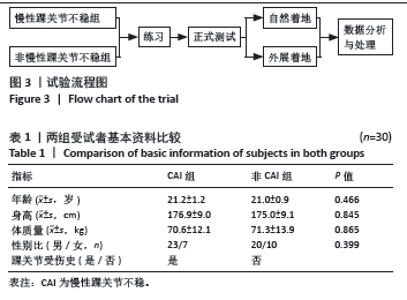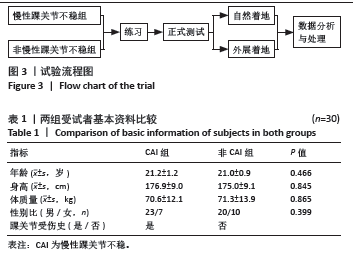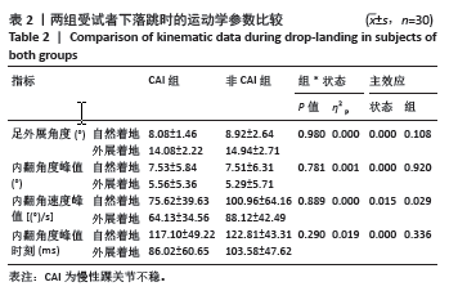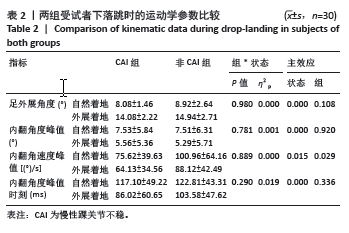Chinese Journal of Tissue Engineering Research ›› 2025, Vol. 29 ›› Issue (9): 1827-1833.doi: 10.12307/2025.146
Previous Articles Next Articles
Increasing toe-out angle during drop-landing can diminish risk of inversion injuries among individuals with chronic ankle instability
Zhu Xiaoxue1, Zhao Qiongqiu1, Zhang Teng2, Wang Dan3, Qiu Jihong4, Song Qipeng2, Shen Peixin2
- 1School of Graduate Education, 2School of Sports and Health, Shandong Sport University, Jinan 250102, Shandong Province, China; 3School of Competitive Sports, 4School of Sports and Health, Shanghai University of Sport, Shanghai 200438, China
-
Received:2023-12-11Accepted:2024-04-06Online:2025-03-28Published:2024-10-10 -
Contact:Shen Peixin, PhD, Associate professor, School of Sports and Health, Shandong Sport University, Jinan 250102, Shandong Province, China Song Qipeng, PhD, Professor, School of Sports and Health, Shandong Sport University, Jinan 250102, Shandong Province, China -
About author:Zhu Xiaoxue, Master candidate, School of Graduate Education, Shandong Sport University, Jinan 250102, Shandong Province, China
CLC Number:
Cite this article
Zhu Xiaoxue, Zhao Qiongqiu, Zhang Teng, Wang Dan, Qiu Jihong, Song Qipeng, Shen Peixin. Increasing toe-out angle during drop-landing can diminish risk of inversion injuries among individuals with chronic ankle instability[J]. Chinese Journal of Tissue Engineering Research, 2025, 29(9): 1827-1833.
share this article
Add to citation manager EndNote|Reference Manager|ProCite|BibTeX|RefWorks
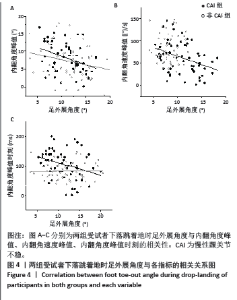
下落跳时的内翻角度峰值(P < 0.001,η2 p=0.270)、内翻角速度峰值(P=0.015,η2 p=0.098)和内翻角度峰值时刻(P < 0.001,η2 p=0.260)均存在显著的状态主效应。两组受试者在外展着地状态下时,以上指标数值均小于自然着地状态。 下落跳时的内翻角速度峰值存在显著的组别主效应(P=0.029,η2 p=0.080)。CAI组受试者自然着地和外展着地时的内翻角速度峰值均小于非CAI组。 2.5 Spearman相关分析结果 Spearman相关分析的结果显示,CAI组着地时的足外展角度与内翻角度峰值(P=0.021,r=-0.310)、内翻角速度峰值(P=0.021,r= -0.312)、内翻角度峰值时刻(P=0.018,r=-0.312)均存在显著的负相关关系;非CAI组着地时的足外展角度与内翻角度峰值(P=0.042,r=-0.278)、内翻角度峰值时刻(P= 0.021,r=-0.309)存在显著的负相关关系,与内翻角速度峰值无显著相关关系(P=0.869,r=0.023)。见图4。 2.6 不良事件 两组受试者测试过程中无不良事件发生。"
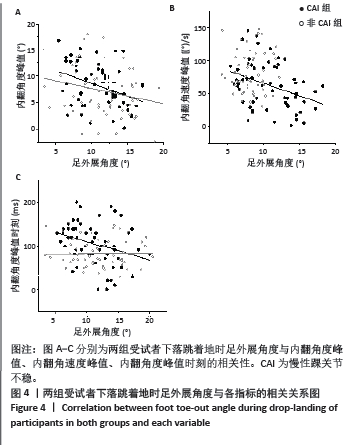
| [1] FONG DT, HONG Y, CHAN LK, et al. A systematic review on ankle injury and ankle sprain in sports. Sports Med. 2007;37(1):73-94. [2] KONRADSEN L, BECH L, EHRENBJERG M, et al. Seven years follow-up after ankle inversion trauma. Scand J Med Sci Sports. 2002;12(3): 129-135. [3] SOBOROFF SH, PAPPIUS EM, KOMAROFF AL. Benefits, risks, and costs of alternative approaches to the evaluation and treatment of severe ankle sprain. Clin Orthop Relat Res. 1984;(183):160-168. [4] GRIBBLE PA, DELAHUNT E, BLEAKLEY C, et al. Selection criteria for patients with chronic ankle instability in controlled research: a position statement of the International Ankle Consortium. J Orthop Sports Phys Ther. 2013;43(8):585-591. [5] DELAHUNT E, COUGHLAN GF, CAULFIELD B, et al. Inclusion criteria when investigating insufficiencies in chronic ankle instability. Med Sci Sports Exerc. 2010;42(11):2106-2121. [6] MCKAY GD, GOLDIE PA, PAYNE WR, et al. Ankle injuries in basketball: injury rate and risk factors. Br J Sports Med. 2001;35(2):103-108. [7] BRINER WW, JR, KACMAR L. Common injuries in volleyball. Mechanisms of injury, prevention and rehabilitation. Sports Med. 1997;24(1):65-71. [8] FONG DT, HA SC, MOK KM, et al. Kinematics analysis of ankle inversion ligamentous sprain injuries in sports: five cases from televised tennis competitions. Am J Sports Med. 2012;40(11):2627-2632. [9] DELAHUNT E, REMUS A. Risk Factors for Lateral Ankle Sprains and Chronic Ankle Instability. J Athl Train. 2019;54(6):611-616. [10] SIMPSON JD, KOLDENHOVEN RM, WILSON SJ, et al. Lower extremity joint kinematics of a simulated lateral ankle sprain after drop landings in participants with chronic ankle instability. Sports Biomech. 2022; 21(4):428-446. [11] TERRIER R, ROSE-DULCINA K, TOSCHI B, et al. Impaired control of weight bearing ankle inversion in subjects with chronic ankle instability. Clin Biomech (Bristol, Avon). 2014;29(4):439-343. [12] TERADA M, GRIBBLE PA. Jump Landing Biomechanics During a Laboratory Recorded Recurrent Ankle Sprain. Foot Ankle Int. 2015; 36(7):842-848. [13] KOSHINO Y, ISHIDA T, YAMANAKA M, et al. Toe-in Landing Increases the Ankle Inversion Angle and Moment During Single-Leg Landing: Implications in the Prevention of Lateral Ankle Sprains. J Sport Rehabil. 2017;26(6):530-535. [14] FUERST P, GOLLHOFER A, WENNING M, et al. People with chronic ankle instability benefit from brace application in highly dynamic change of direction movements. J Foot Ankle Res. 2021;14(1):13. [15] BEUMER A, VAN HEMERT WL, SWIERSTRA BA, et al. A biomechanical evaluation of the tibiofibular and tibiotalar ligaments of the ankle. Foot Ankle Int. 2003;24(5):426-429. [16] KHAN SS, KHAN SJ, USMAN J. Effects of toe-out and toe-in gait with varying walking speeds on knee joint mechanics and lower limb energetics. Gait Posture. 2017;53:185-192. [17] GEHRING D, FASCHIAN K, LAUBER B, et al. Mechanical instability destabilises the ankle joint directly in the ankle-sprain mechanism. Br J Sports Med. 2014;48(5):377-382. [18] MOKHTARZADEH H, YEOW CH, GOH JCH, et al. Antagonist muscle co-contraction during a double-leg landing maneuver at two heights. Comput Methods Biomech Biomed Engin. 2017;20(13):1382-1393. [19] ANDERSEN TE, FLOERENES TW, ARNASON A, et al. Video analysis of the mechanisms for ankle injuries in football. Am J Sports Med. 2004; 32(1 Suppl):69s-79s. [20] HA SC, FONG DT, CHAN KM. Review of ankle inversion sprain simulators in the biomechanics laboratory. Asia Pac J Sports Med Arthrosc Rehabil Technol. 2015;2(4):114-121. [21] FONG DT, CHAN YY, MOK KM, et al. Understanding acute ankle ligamentous sprain injury in sports. Sports Med Arthrosc Rehabil Ther Technol. 2009;1:14. [22] BHASKARAN D, WORTLEY M, CHEN Q, et al. Effect of a combined inversion and plantarflexion surface on ankle kinematics and EMG activities in landing. J Sport Health Sci. 2015;4(4):377-383. [23] BECHARD DJ, BIRMINGHAM TB, ZECEVIC AA, et al. Toe-out, lateral trunk lean, and pelvic obliquity during prolonged walking in patients with medial compartment knee osteoarthritis and healthy controls. Arthritis Care Res (Hoboken). 2012;64(4):525-532. [24] GU L, QIU H, ZHANG S, et al. [Analysis of the relevance of age and toe out angle of normal adults’ gait]. Sheng Wu Yi Xue Gong Cheng Xue Za Zhi. 2018;35(1):45-48. [25] MCILROY WE, MAKI BE. Preferred placement of the feet during quiet stance: development of a standardized foot placement for balance testing. Clin Biomech (Bristol, Avon). 1997;12(1):66-70. [26] BENNOUR S, ULRICH B, LEGRAND T, et al. Effects of foot progression angle on knee biomechanics during gait modification. Comput Methods Biomech Biomed Engin. 2017;20(sup1):17-18. [27] SINCLAIR J, TAYLOR PJ, HOBBS SJ. Digital filtering of three-dimensional lower extremity kinematics: an assessment. J Hum Kinet. 2013;39: 25-36. [28] COHEN J. Statistical Power Analysis for the Behavioural Sciences. Hillsdale, NJ: Earlbaum Associates. 1988. [29] KIM H, SON SJ, SEELEY MK, et al. Altered movement strategies during jump landing/cutting in patients with chronic ankle instability. Scand J Med Sci Sports. 2019;29(8):1130-1140. [30] GUTIERREZ GM, KAMINSKI TW, DOUEX AT. Neuromuscular control and ankle instability. PM R. 2009;1(4):359-365. [31] DULLAERT K, HAGEN J, KLOS K, et al. The influence of the Peroneus Longus muscle on the foot under axial loading: A CT evaluated dynamic cadaveric model study. Clin Biomech (Bristol, Avon). 2016;34:7-11. [32] KONRADSEN L. Sensori-motor control of the uninjured and injured human ankle. J Electromyogr Kinesiol. 2002;12(3):199-203. [33] CZAJKA CM, TRAN E, CAI A N, et al. Ankle sprains and instability. Med Clin North Am. 2014;98(2):313-329. [34] MEDINA MCKEON JM, HOCH MC. The Ankle-Joint Complex: A Kinesiologic Approach to Lateral Ankle Sprains. J Athl Train. 2019;54(6): 589-602. [35] LEE PJ, ROGERS EL, GRANATA KP. Active trunk stiffness increases with co-contraction. J Electromyogr Kinesiol. 2006;16(1):51-57. [36] GUTIERREZ GM, KNIGHT CA, SWANIK CB, et al. Examining neuromuscular control during landings on a supinating platform in persons with and without ankle instability. Am J Sports Med. 2012; 40(1):193-201. [37] LI Y, KO J, WALKER MA, et al. Does chronic ankle instability influence lower extremity muscle activation of females during landing? J Electromyogr Kinesiol. 2018;38:81-87. [38] BONASERA SJ, NICHOLS TR. Mechanical actions of heterogenic reflexes among ankle stabilizers and their interactions with plantarflexors of the cat hindlimb. J Neurophysiol. 1996;75(5):2050-2070. [39] HAMOUDA A, KENNEY L, HOWARD D. Dealing with time-varying recruitment and length in Hill-type muscle models. J Biomech. 2016; 49(14):3375-3380. [40] HAEUFLE DF, GÜNTHER M, BAYER A, et al. Hill-type muscle model with serial damping and eccentric force-velocity relation. J Biomech. 2014;47(6):1531-1536. [41] SIMPSON JD, STEWART EM, TURNER AJ, et al. Neuromuscular control in individuals with chronic ankle instability: A comparison of unexpected and expected ankle inversion perturbations during a single leg drop-landing. Hum Mov Sci. 2019;64:133-141. [42] SIMPSON JD, STEWART EM, RENDOS NK, et al. Anticipating ankle inversion perturbations during a single-leg drop landing alters ankle joint and impact kinetics. Hum Mov Sci. 2019;66:22-30. [43] HERTEL J. Sensorimotor deficits with ankle sprains and chronic ankle instability. Clin Sports Med. 2008;27(3):353-370, vii. |
| [1] | Zhang Xinxin, Gao Ke, Xie Shidong, Tuo Haowen, Jing Feiyue, Liu Weiguo. Network meta-analysis of non-surgical treatments for foot and ankle ability and dynamic balance in patients with chronic ankle instability [J]. Chinese Journal of Tissue Engineering Research, 2025, 29(9): 1931-1944. |
| [2] | Lu Jieming, Li Yajing, Du Peijie, Xu Dongqing. Effects of artificial turf versus natural grass on biomechanical performance of the lower limbs in young females during jump-landing [J]. Chinese Journal of Tissue Engineering Research, 2025, 29(6): 1101-1107. |
| [3] | Wu Yihan, Liu Zhongqiang, Wei Qiaoye, Liu Mingdong, Chen Keyi, Li Zhigang. Effect of balance training with different visual conditions on proprioception in patients with chronic ankle instability [J]. Chinese Journal of Tissue Engineering Research, 2025, 29(5): 1050-1057. |
| [4] | Guo Ping, Wang Juan. Bilateral lower limb biomechanical abnormalities in patients with unilateral chronic ankle instability [J]. Chinese Journal of Tissue Engineering Research, 2025, 29(32): 6920-6926. |
| [5] | Zhang Sizhuo, Liu Xiaoqian, Wang Guanglan. Effects of visual interference on biomechanical characteristics of lower limbs in athletes after anterior cruciate ligament reconstruction [J]. Chinese Journal of Tissue Engineering Research, 2025, 29(20): 4223-4229. |
| [6] | Liu Yanhao, Dong Shiyu, Liu Ziyin, Song Qipeng, Shen Peixin. Unilateral chronic ankle instability affects bilateral postural stability, proprioception, plantar tactile sensation and muscle strength [J]. Chinese Journal of Tissue Engineering Research, 2025, 29(17): 3572-3578. |
| [7] | Liu Qing, Ma Gang, Cao Jianling, Zhang Yu, Xiong You, He Ruibo. Effects of different types of taping on ankle joint kinesiology during walking in patients with chronic ankle instability [J]. Chinese Journal of Tissue Engineering Research, 2025, 29(14): 2989-2994. |
| [8] | Zhang Lili, Zhang Xinglai, Zhang Jie, Zheng Jiejiao. Effect of visual feedback on landing biomechanics in chronic ankle instability patients [J]. Chinese Journal of Tissue Engineering Research, 2024, 28(6): 900-904. |
| [9] | Su Yuying, Li Wei, Shi Yu, Pan Changbo. Effects of different exercise interventions on symptoms and dynamic balance ability of chronic ankle instability: a systematic review and Meta-analysis [J]. Chinese Journal of Tissue Engineering Research, 2024, 28(32): 5217-5224. |
| [10] | Xie Wei, Zhao Jingjing, Hao Cheng, Li Zi, Fang Zhenhua. Treatment of high ankle sprains with Suture-button elastic fixation assisted by arthroscopy [J]. Chinese Journal of Tissue Engineering Research, 2024, 28(30): 4848-4853. |
| [11] | Lin Qinzhao, Wei Mengli, Zhong Yaping, Wu Qian, Zhou Botao, Wang Haifeng. Effect of transcranial direct current stimulation on human single-leg landing stability [J]. Chinese Journal of Tissue Engineering Research, 2024, 28(26): 4209-4215. |
| [12] | Wang Yuetong, Peng Liang, Su Yuying, Liu Jiajun. Effect of balance training on chronic ankle instability: a meta-analysis [J]. Chinese Journal of Tissue Engineering Research, 2024, 28(24): 3930-3936. |
| [13] | Xue Boshi, Lin Changrui, Zheng Liangliang, Yang Chen, Zhou Zhipeng. Core stability training reduces risk of anterior cruciate ligament injury in landing movements [J]. Chinese Journal of Tissue Engineering Research, 2024, 28(16): 2467-2472. |
| [14] | Zhang Jinqin, Cui Jian, Gao Xiaolin, Shi Yongjin, Zhu Chao, Huang Peng. The landing error scoring system as a screening tool for non-contact injury risk in college soccer athletes [J]. Chinese Journal of Tissue Engineering Research, 2024, 28(11): 1641-1646. |
| [15] | Wang Ling, Chen Peng, Wang Guanglan, Zheng Cheng. Effects of kinesio taping on chronic ankle instability: a systematic review and Meta-analysis [J]. Chinese Journal of Tissue Engineering Research, 2023, 27(14): 2283-2290. |
| Viewed | ||||||
|
Full text |
|
|||||
|
Abstract |
|
|||||
